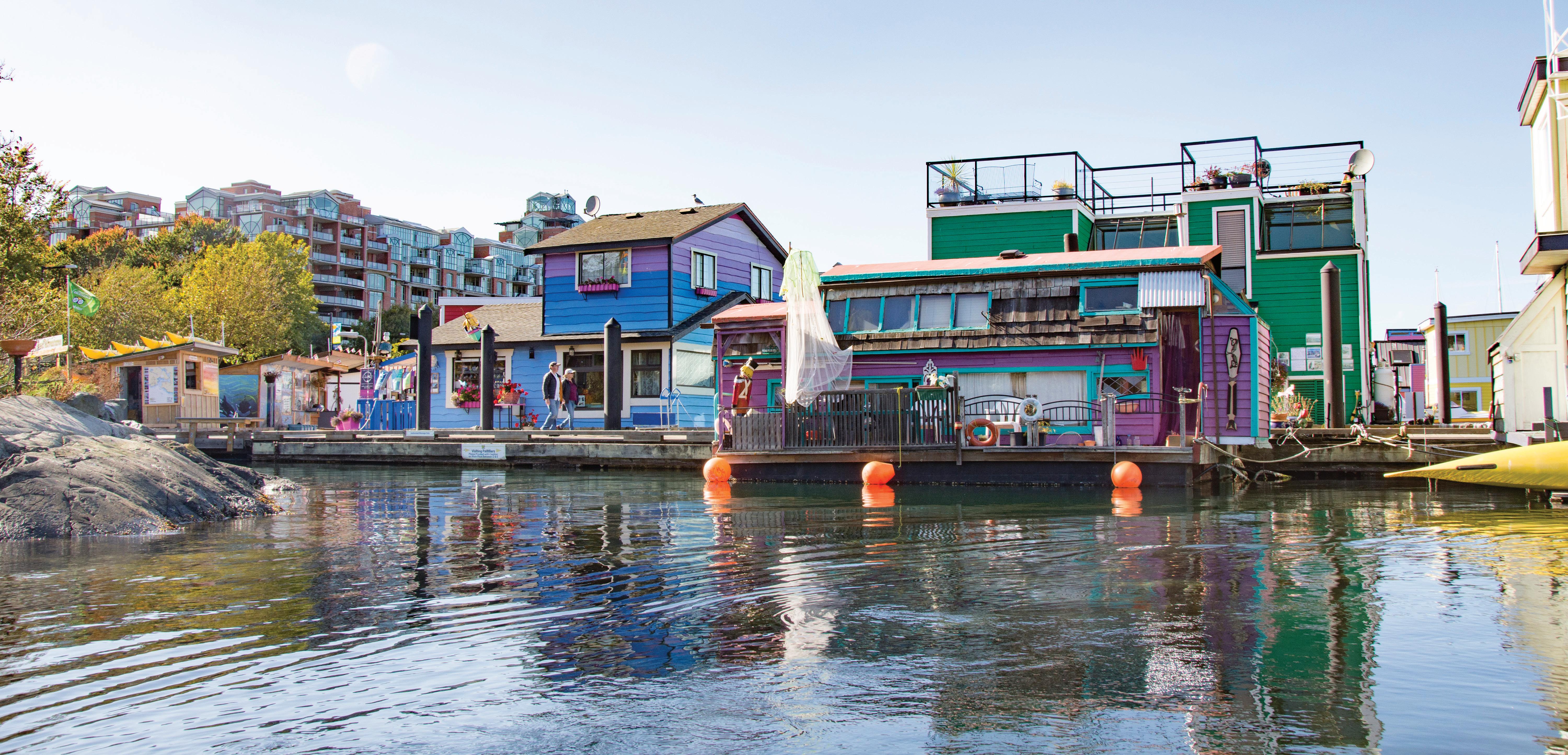
8 minute read
REAL ESTATE
REAL ESTATE Provincial policy discourages more float homes
by Carlito Pablo
Advertisement
Doug Taylor swears by the view from his home.
“Oh, my goodness,” Taylor says about the Vancouver skyline, especially at night. “It’s just beautiful.” Taylor lives on a float home on Burrard Inlet with his wife, Jewel, in North Vancouver.
Moreover, Taylor works as a realtor, and his listings include float homes.
As someone who has lived in one since 2012, Taylor can tell clients from personal experience about the joys of living on the water.
Taylor’s float home is at the Creek Marina and Boatyard. The Squamish Nation owns the marina, and the float-home village was established in 2010.
The village is one of a few in B.C.
In a separate interview, Kelly McCloskey noted that developing new ones hasn’t been easy. McCloskey is a resident at Ladner Reach Marina and the president of the Floating Home Association of B.C. (FHABC).
He said that the B.C. government has a long-standing policy of not encouraging new communities. “Their official policy is no new floating-home community developments,” McCloskey told the Straight by phone.
He explained that this is a huge hurdle because the B.C. government owns most of the province’s foreshore at streams, rivers, lakes, and the ocean. Foreshore areas consist of the land between low and high water.
“We’ve approached the government and asked them to revisit and revise that policy because today’s floating-home communities are very vibrant,” McCloskey said.
A January 21, 2019, version of the province’s policy defines a float home as a “structure built on a floatation system”. It is “used for permanent residential habitation and is not intended for navigation, nor usable as a navigable craft”.
Meanwhile, a float-home community “includes two or more floating homes that are physically connected to the shoreland and to each other by a common walkway or ramp”. It is “serviced by a potable water system, electrical system, and sewage disposal system approved by the responsible authority”.
“Applications for floating home community use of aquatic Crown land will not be accepted,” the policy states.
The province defines aquatic Crown land as “all the land, including the foreshore, from the high water mark out to the limits of provincial jurisdiction”.
However, a regional executive director with the Ministry of Forests, Lands, Natural Resource Operations and Rural Development, which is the agency responsible for implementing the policy, “may accept a written proposal from a proponent”.
The policy provides that such a proposal should have the support of local government.
FHABC secretary and spokesperson Sandy McKellar told the Straight that there are about 800 float homes across the province. She recalled that the province’s policy of not encouraging new communities started sometime in the 1990s.
McKellar thinks it may have something to do with early float homes associated with logging and fishing camps. They were towed from one location to another.
“They were, essentially, water squatters,” McKellar said.
In contrast, McKellar noted that today’s homes stay in one location and are hooked up to utilities, especially sewage. “A floating home is connected to an address, and it stays there,” McKellar said.
McCloskey said the FHABC does not promote float homes as an “entry level” form of housing. He explained that although the homes generally cost less than a land-based house, they come with moorage fees that some may find quite high.
For example, the moorage fee of a home for sale at the Sea Island Village Marina on Granville Island in Vancouver amounts to $941 per month. Taylor listed the 4-1301 Johnston Street property with an asking price of $1,295,00. He said in the interview that he has received offers for the two-bedroom residence.
The Straight asked McCloskey if there is a case to be made about the need for more float-home communities as part of discussions around housing in general.
McCloskey said the argument for this is mainly about increasing the current limited opportunities for those who want a lifestyle connected with this form of housing. “There’s tiny homes, too, and tiny homes will never drive a tremendous amount of supply to the market. But as a component, tiny homes play a role, and so I think floating homes fit very much into that same kind of diversified opportunity.”
In North Vancouver, Taylor recalled that he and his wife bought their first float home in 2012 at the Creek Marina and Boatyard after their three children moved out.
“I was cutting the grass and the hedges and, you know, maintaining a house, and we decided we’d like to travel and do some bit of a different lifestyle,” Taylor related.
They later sold that one and acquired another. Last year, they moved into another one, also in the same marina.
“It’s a very relaxing lifestyle,” Taylor said. “When you come down onto the water, you feel like you’ve left the city. So I tell people it’s sort of like living at the cottage or a vacation home all year long.” g
All the float homes at Victoria’s Fisherman’s Wharf have access to potable water, 30-amp power, and sewage hookups to prevent discharge of “black water”. Photo by Sandy McKellar.
907 1720 BARCLAY ST I $419,000
Welcome to LANCASTER GATE, a definitive Leasehold in the heart of the West End. A few steps to Denman Street shopping, community centre & all your favourite restaurants. Stroll over to Stanley Park, tennis courts & the beach Bright, spacious NW-facing unit has views of the city, mountains & water. Major upgrades in 2011, incl engineered flooring, fresh paint, kitchen & bathroom + new bedroom carpet in 2018. Very well cared for building, incl upgraded dbl glazed windows 1 Parking & storage included. Rentals allowed - great ROI. SHOWINGS BY APPT: FRI May 14th, 11 - noon SHOWINGS BY APPT: SAT May 15th, 2 - 3pm





STONEHOUSE
TEAM REAL ESTATE ADVISORS
604 255 7575
EMAILUS@STONEHOUSETEAM.COM
REAL ESTATE Yan’s 2015 study still stirs foreign-money debate
by Charlie Smith
Five years ago, I knew something weird was going on in Vancouver when I wrote a column in response to an article by Pete McMartin in the Vancouver Sun.
McMartin suggested that racism was underlying some of the public’s reaction to the overheated real-estate market. My column focused attention on boomer journalists who lived through an ugly raced-based housing debate in the late 1980s and early 1990s.
For this, I was pilloried on social media. I shouldn’t have been surprised. The same thing occurred nearly a year earlier when Straight contributor Matt Hern wrote a column arguing that Vancouver’s core real-estate problem was “profiteering”—not whether buyers were of Chinese ancestry. He, too, was roasted.
A similar thing also happened to former Straight reporter Travis Lupick when he wrote a two-part series in 2016 about how the foreign-buyers narrative came to dominate Vancouver media coverage of housing issues. Andy Yan, now the director of SFU’s City Program, was one of those who took exception. He was irritated by longtime antiractist activist Victor Wong’s comments about one of Yan’s housing studies.

Housing researcher Andy Yan (left, photo by SFU), now director of the City Program at SFU, worked with Attorney General David Eby on a 2015 study that Eby has since apologized for.
Wong said that when Yan used nonanglicized Chinese names as a “proxy” in a paper about 172 housing transactions, it conflated foreign nonresidents with newcomers who live here and who have the right to buy whatever home they like. This month, Wong pointed out that foreign buyers accounted for fewer than one percent of the $15 billion in residential transactions in Vancouver last year. It came in the wake of Bloomberg announcing that Vancouver is the anti-Asian “hate crime capital” of North America. Recently, Attorney General David Eby told the provincial money-laundering inquiry that he was sorry for supplying landtitle information to Yan for his study. Yan has expressed no public regrets. Rather, he declared gratitude over Twitter to “the diverse community behind me and the scholars and researchers on whose shoulders and work I stand on”. His admirers also remain firmly supportive. Justin Fung, a cofounder of one group that’s been raising the alarm about foreign money for years, tweeted that Yan should be given the key to the city. Fung also emphasized over Twitter how people forget that the B.C. Liberals “had deliberately not collected data on where homebuyers were coming from”.
Data analyst Jennifer Bradshaw, on the other hand, maintained that Yan “filled a void for ‘data’ that could be used to confirm what everyone wanted to hear: that the housing crisis wasn’t caused by decades of underfunding social housing or a housing system ‘built by white people to enrich generations of white people’.”
Bradshaw also tweeted that Yan’s data offered journalists like Kerry Gold, Douglas Todd, and Lynda Steele what they wanted to hear: that high housing prices were “rich Asians’ fault”.
“Any tiny piece of ‘data’ would do, no matter how tiny and insignificant,” Bradshare insisted. “And Yan provided it, and thus, the scapegoat donned its paper thin veneer of respectability.
“That was enough for so many of the rich ruling class, many of whom have enjoyed intergenerational real estate wealth in their family, to not look in the mirror,” she added. g












